
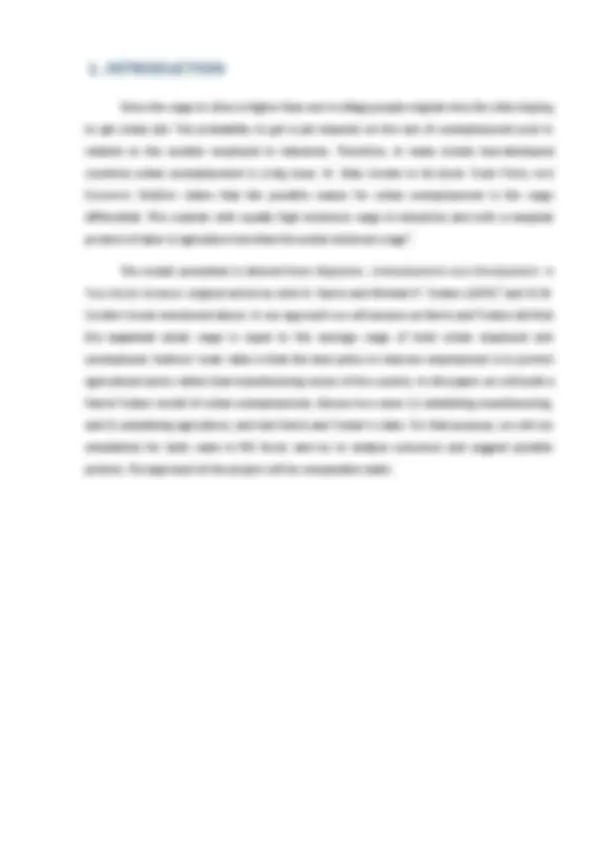
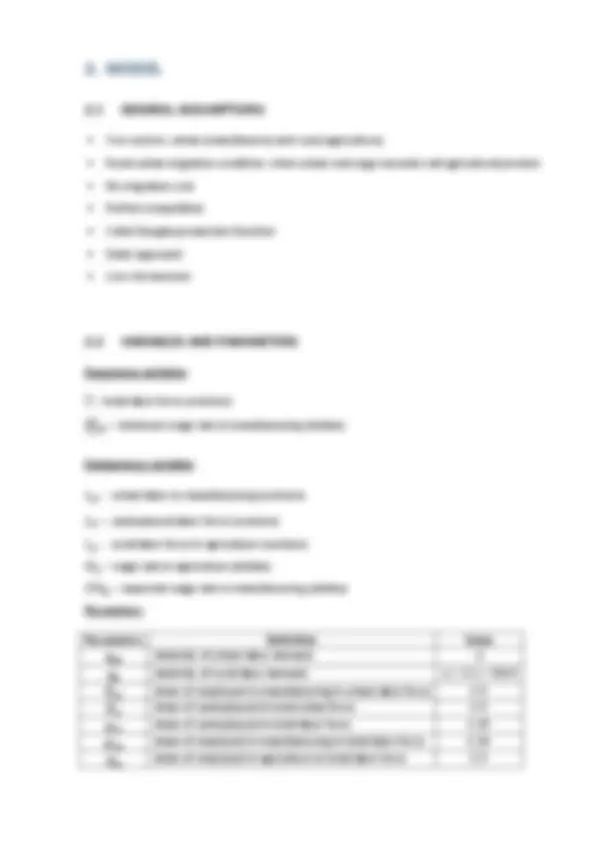
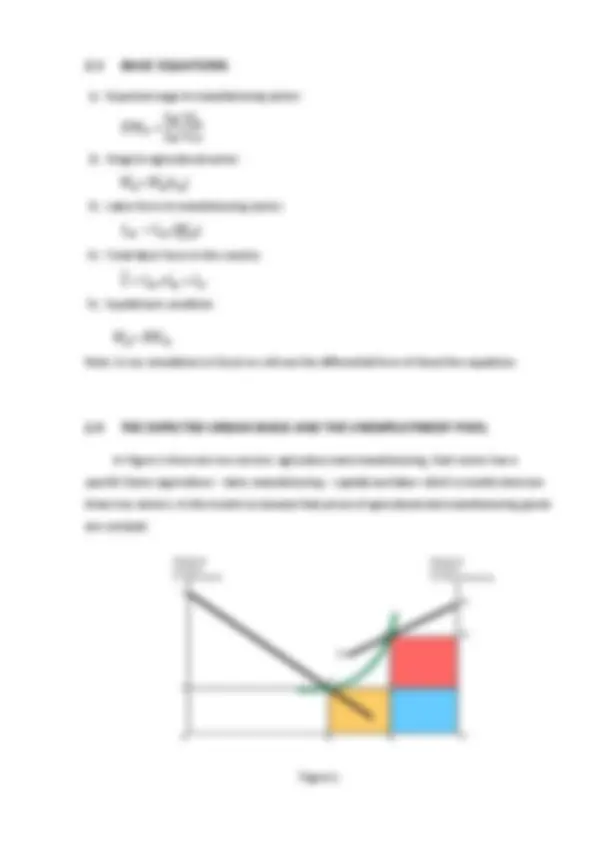
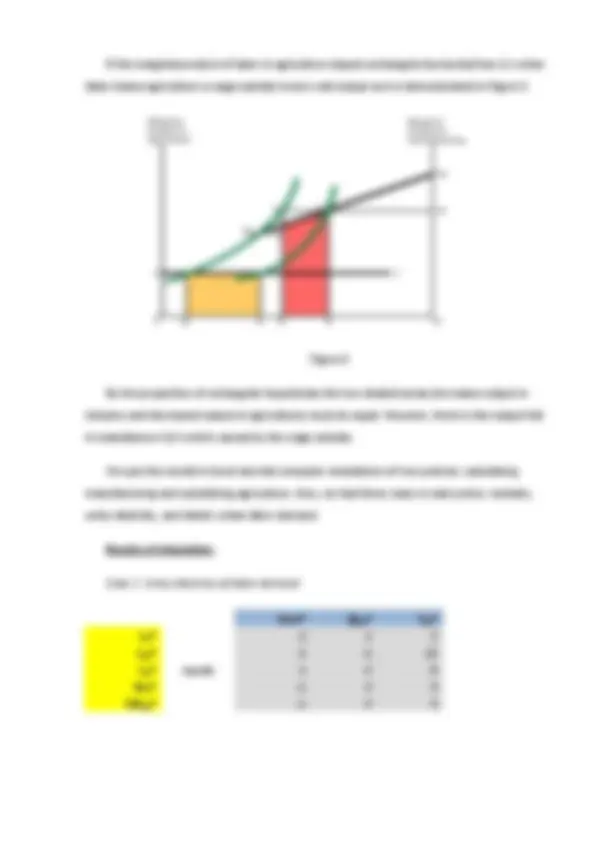
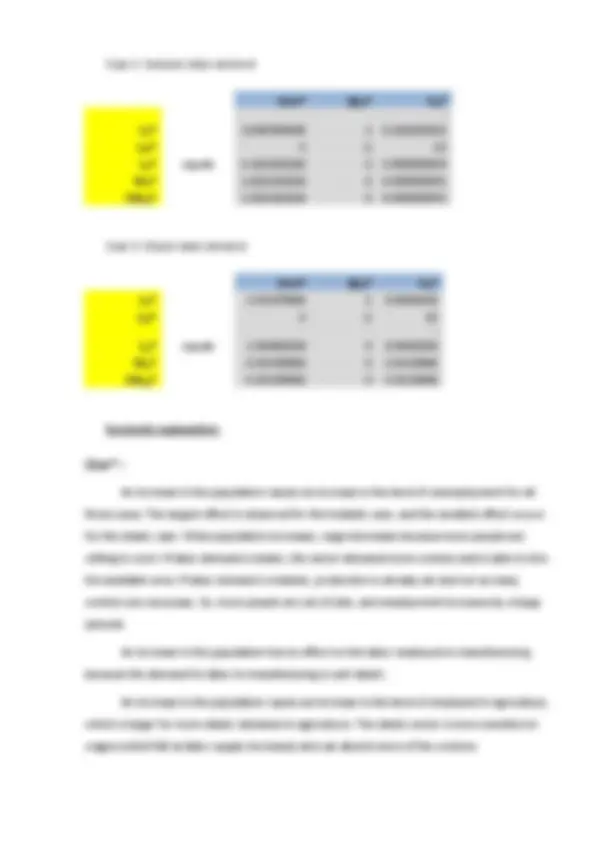
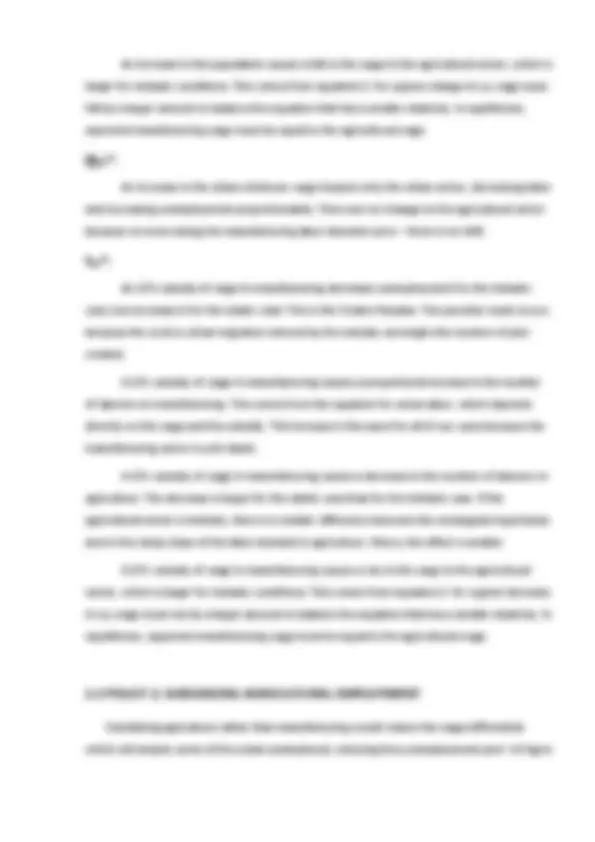
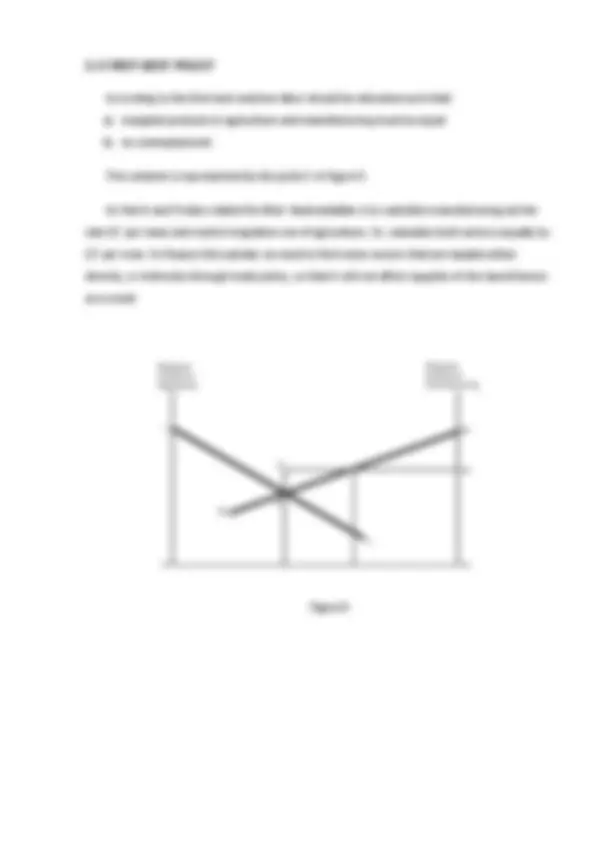
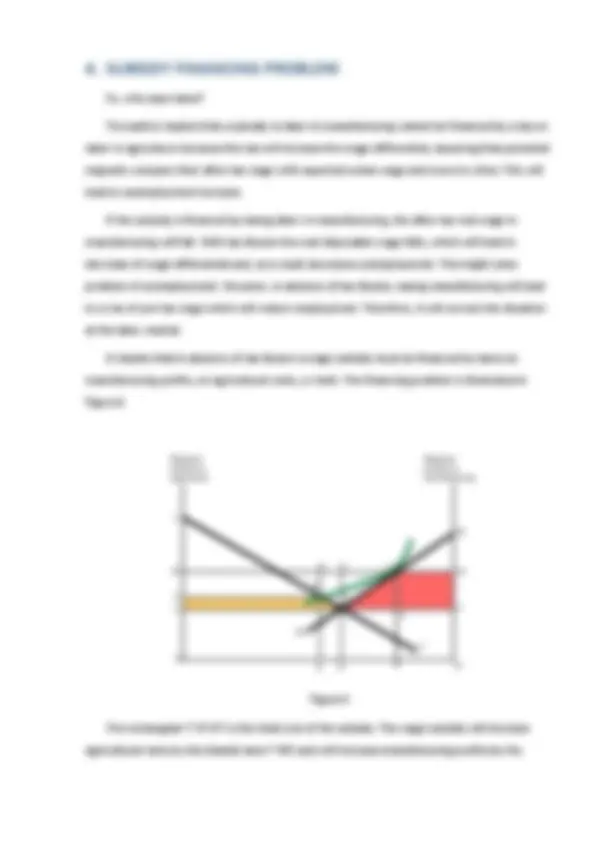
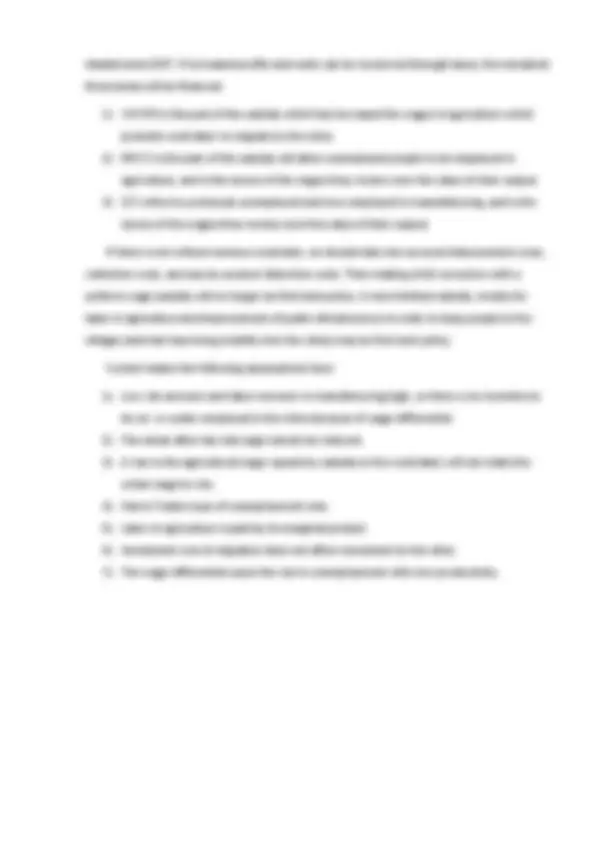


Study with the several resources on Docsity

Earn points by helping other students or get them with a premium plan


Prepare for your exams
Study with the several resources on Docsity

Earn points to download
Earn points by helping other students or get them with a premium plan
Community
Ask the community for help and clear up your study doubts
Discover the best universities in your country according to Docsity users
Free resources
Download our free guides on studying techniques, anxiety management strategies, and thesis advice from Docsity tutors
In this case economy may have high rates of unemployment. The equilibrium condition of this model is when expected rural wage is equal to rural wage.
Typology: Lecture notes
1 / 17

This page cannot be seen from the preview
Don't miss anything!










2.1 General Assumptions 2.2 Variables and Parameters 2.3 Basic equations 2.4 The expected urban wage and the unemployment pool
Two sectors: urban (manufacture) and rural (agriculture) Rural-urban migration condition: when urban real wage exceeds real agricultural product No migration cost Perfect competition Cobb-Douglas production function Static approach Low risk aversion
Exogenous variables
̅ – total labor force (workers)
Endogenous variables
Parameters Definition Value
share of employed in manufacturing in urban labor force 0. share of unemployed in total urban force 0. share of unemployed in total labor force 0. share of employed in manufacturing in total labor force 0. share of employed in agriculture in total labor force 0.
Note: in our simulations in Excel we will use the differential form of these five equations.
In Figure 1 there are two sectors: agriculture and manufacturing. Each sector has a specific factor (agriculture – land, manufacturing – capital) and labor which is mobile between these two sectors. In this model we assume that prices of agricultural and manufacturing goods are constant.
Figure 1
When we subsidize manufacturing as it can be seen from Figure 2 by QJ’ per man we expand manufacturing output by N’N. The shaded area N’QJN is the value of extra output in manufacturing. Then we draw a new rectangular hyperbola R’J’, and get the new equilibrium allocation. Labor in agriculture declines by G’G, and the output also declines by the area of the shaded area G’R’RG. So we need to compare the two shaded areas in order to measure effect on total output. This depends on the size of the unemployment pool. The flatter the slope of LL’ and steeper the slope of MM’, the bigger number of the unemployment people and lower real output.
Figure 2
Can we restore full employment subsidizing manufacturing? Yes. More and more workers will leave agriculture increasing marginal product in agriculture till it reaches the fixed minimum wage in industry. Here both wages are equalized, so there will be no unemployment. In Figure 2, agricultural output declines by OG’’. Because marginal product of labor in manufacturing will be below that in agriculture, this would not be first-best solution, and not even second-best solution. However, a very low wage subsidy may maximize real output.
If the marginal product of labor in agriculture stayed unchanged (horizontal line LL’) when labor leaves agriculture a wage subsidy lowers real output as it is demonstrated in Figure 3.
Figure 3
By the properties of rectangular hyperbolae the two shaded areas (increases output in industry and decreased output in agriculture) must be equal. However, there is the output fall in manufacture QJ’J which caused by the wage subsidy.
We put this model in Excel and did computer simulations of two policies: subsidizing manufacturing and subsidizing agriculture. Also, we had three cases in each policy: inelastic, unity elasticity, and elastic urban labor demand.
Results of simulation:
Case 1: Unity elasticity of labor demand
Lbar^ WM^ SM^ LU^ 2 1 0 LM^ 0 - 1 10 LA^ equals 1 0 - 5 WA^ - 1 0 5 EWM^ - 1 0 5
An increase in the population causes a fall in the wage in the agricultural sector, which is larger for inelastic conditions. This comes from equation 2: for a given change in La, wage must fall by a larger amount to balance the equation that has a smaller elasticity. In equilibrium, expected manufacturing wage must be equal to the agricultural wage.
An increase in the urban minimum wage impacts only the urban sector, decreasing labor and increasing unemployment proportionately. There are no changes in the agricultural sector because we move along the manufacturing labor demand curve – there is no shift.
An 10% subsidy of wage in manufacturing decreases unemployment for the inelastic case, but increases it for the elastic case! This is the Todaro Paradox. This peculiar result occurs because the rural to urban migration induced by the subsidy outweighs the number of jobs created.
A 10% subsidy of wage in manufacturing causes a proportional increase in the number of laborers in manufacturing. This comes from the equation for urban labor, which depends directly on the wage and the subsidy. This increase is the same for all of our cases because the manufacturing sector is unit elastic.
A 10% subsidy of wage in manufacturing causes a decrease in the number of laborers in agriculture. The decrease is larger for the elastic case than for the inelastic case. If the agricultural sector is inelastic, there is a smaller difference between the rectangular hyperbolas due to the steep slope of the labor demand in agriculture. Hence, the effect is smaller.
A 10% subsidy of wage in manufacturing causes a rise in the wage in the agricultural sector, which is larger for inelastic conditions. This comes from equation 2: for a given decrease in La, wage must rise by a larger amount to balance the equation that has a smaller elasticity. In equilibrium, expected manufacturing wage must be equal to the agricultural wage.
Subsidizing agriculture rather than manufacturing would reduce the wage differential which will employ some of the urban unemployed, reducing thus unemployment pool. In Figure
4 TJ is the wage subsidy in agriculture per man. Employment in manufacturing stays unchanged at NO*, but employment in agriculture rises from OG to ON, absorbing all the unemployed.
Figure 4
The shaded area GRTN is the extra agricultural output and pure gain. Thus, the author claims that agriculture rather than manufacturing must be subsidized. Even though there is a gain, this policy is still not the first-best because if there is no unemployment it will lead to excessive movement of labor into agriculture compared to the first-best solution.
Results of simulation:
Case 1: Unity elasticity of labor demand
Lbar^ WM^ SA^ LU^ 2 1 - 10 LM^ 0 - 1 0 LA^ equals 1 0 5 WA^ - 1 0 5 EWM^ - 1 0 5
Case 2: Inelastic labor demand
According to the first-best solution labor should be allocated such that: a) marginal products in agriculture and manufacturing must be equal b) no unemployment
This solution is represented by the point Z in Figure 5.
As Harris and Todaro stated the first – best solution is to subsidize manufacturing (at the rate ZZ’ per man) and restrict migration out of agriculture. Or, subsidize both sectors equally by ZZ’ per man. To finance this subsidy we need to find some sectors that are taxable either directly, or indirectly through trade policy, so that it will not affect supplies of the taxed factors as a result.
Figure 5
So, who pays taxes? The author implies that a subsidy to labor in manufacturing cannot be financed by a tax on labor in agriculture because this tax will increase the wage-differential, assuming that potential migrants compare their after-tax wage with expected urban wage and move to cities. This will lead to unemployment increase.
If the subsidy is financed by taxing labor in manufacturing, the after-tax real wage in manufacturing will fall. With tax illusion the real disposable wage falls, which will lead to decrease of wage-differential and, as a result decreases unemployment. This might solve problem of unemployment. However, in absence of tax illusion, taxing manufacturing will lead to a rise of pre-tax wage which will reduce employment. Therefore, it will worsen the situation at the labor market.
It implies that in absence of tax illusion a wage subsidy must be financed by taxes on manufacturing profits, on agricultural rents, or both. The financing problem is illustrated in Figure 6.
Figure 6 The rectangular T’W’WT is the total cost of the subsidy. The wage-subsidy will increase agricultural rents by the shaded area T’VRZ and will increase manufacturing profits by the
Harris Todaro model explains some issues of rural-urban migration. This migration happens in case when expected rural income is higher than rural wages. In this case economy may have high rates of unemployment. The equilibrium condition of this model is when expected rural wage is equal to rural wage. When government subsidize manufacturing sector Harris Todaro paradox may happen. According to the authors job creation instead of dealing with unemployment problem actually may cause increase of unemployment. This happens when urban-rural wage differential is high enough, so rural workers move to the cities hoping to find a job with high wage. Obviously, not all these workers succeed in finding jobs which leads to unemployment. Another issue is that inducing minimum wages creates labor market distortions. Therefore, policy makers should not set the minimum wage rates. In addition, simulations showed that different policies’ outcomes depend on elasticity of labor demand in different sectors and on marginal product of labor. As Harris and Todaro suggested the first-best policy would be subsidizing manufacturing along with restrictions of rural migration.